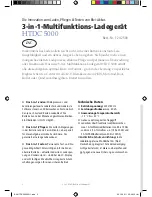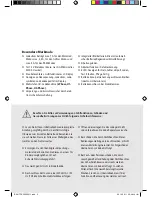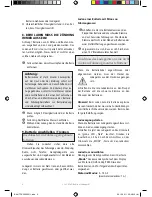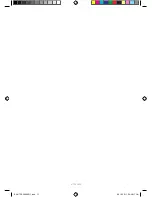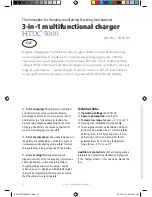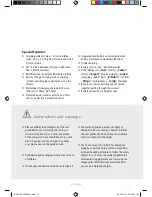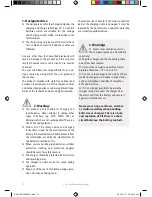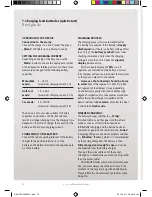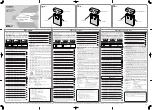
15
HTDC 5000
4. Area of use
For all 12 volt starter batteries, e.g. for motorbikes,
cars, motor homes, boats, tractor lawnmowers,
etc. Regardless of whether wet, maintenance-free,
fl eece, gel pure lead or similar lead batteries: The
instructions issued by the battery manufacturers
must always be followed when charging.
5. Dangers
Servicing and repairs may only be carried out
by an expert or by trained people under the
management and supervision of a specialist
electrician.
In the case of damage which is readily apparent,
e.g. evolution of smoke, ingress of liquids etc.,
disconnect the charger from the mains and from
the battery immediately. Have the fault corrected
by a specialist as soon as possible.
Danger posed by reverse polarity, short circuit
and contact with battery acid – it is essential
that you follow the safety advice issued by the
battery manufacturers.
Attention!
Battery acid is highly corrosive. Treat
any acid which splashes on the skin
or on clothing immediately with
soapy solution and then rinse with
lots of water. If acid splashes or squirts into the
eyes, rinse immediately with lots of water and
consult a doctor immediately.
6. Safety
Make sure there is suffi cient ventilation in the
room during charging.
With batteries which are not maintenance-
free, open the cell plugs prior to charging and
check the acid level. If lead batteries which are
not maintenance-free are charged for a lengthy
period of time, check the acid level from time to
time.
Check the charging process on a regular basis.
Avoid open fi re, naked fl ames and sparks in
the vicinity of the battery being charged (risk
of explosion caused by detonating gas). Always
follow the charging instructions issued by the
battery manufacturer.
Make sure that no highly fl ammable
objects (wood, cloths, steel wool etc.)
are located in the vicinity of the charger
or on or beneath the charger. The charging or
mains cable must not be modifi ed, lengthened or
shortened. It must also not be bent or squashed, nor
be guided over components with sharp edges. Live
cables or wires with which the charger is connected
must always be examined for any insulation faults,
breaks, pinch points or kinks before and after use.
Batteries must not be short-circuited or thrown
into a fi re, there is a risk of fi re and explosion!
Beware! Do not continue the charging
process if the battery is defective.
Signs of a defective battery:
Smell of gas in the air
When you touch the battery, individual cells
seem to have a different temperature
Mechanical or thermal deformation of the
battery housing or charger
Different level of liquid in the cells, or escape of
liquid
BA-HTDC5000-2011.indd 15
26.10.2011 20:28:18 Uhr


